|
VI.
PLANT COMMUNITIES
D. RIPARIAN COMMUNITIES
Once
water is in the ground after it rains, the soil acts
like a sponge, holding the water until it is either
taken up by plants or gradually pulled downward by
gravity into underground aquifers and springs or above-ground
seeps and creeks. Factors affecting the flow of a
stream are the rainfall, the timing of the rainy season,
the timing of primary plant growth and water usage,
watershed size, and bedrock geology. In Poly Canyon,
rainfall is typically between 20 and 30 inches, occurring
between October and April. Primary plant growth and
water usage is generally from April through September.
Larger watersheds tend to collect more rain, but smaller
ones, like Poly Canyon, are subject to more abrupt
changes brought on by natural episodic flooding, drought,
or fire or by anthropogenic activities such as overgrazing,
mountain biking, hiking, and pesticide runoff. If
a stream bed is solid bedrock, there is no chance
for water to penetrate, and all of it flows downstream.
On the other hand, water may penetrate the stream
bed to such a degree that it flows beneath the surface.
Brizzolara Creek experiences both of these scenarios.
The availability of moisture at the surface affects
the nature of the community, and it is the moist banks
and shores of fresh water streams, rivers, seeps,
springs, lakes, and estuarine marshes that give rise
to riparian communities. Riparius stems from ripa,
Latin for the "bank" or "shore of a stream or river."
Riparian
communities are dominated by one to several species
of anemophilous (wind-pollinated), winter-deciduous
trees with broad and/or soft-textured leaves. This
seems anomalous in the California setting given the
primarily evergreen nature of chaparral, coastal scrub,
and coastal live oak woodlands. "Deciduous islands
in an evergreen sea," our riparian forests are minor
refuges for riparian plants that flourished in a very
different climate during the Tertiary period millions
of years ago. While adjacent dry areas are stressed
by drought in summer, productivity does not suffer
in the riparian corridor where water and maximum sunlight
are available simultaneously. Riparian communities
are not restricted by climatic or edaphic conditions.
However, their size and species composition vary with
altitude, topography, the characteristics of their
banks, the amount of water carried by them, and the
proximity and size of adjacent underground water resources.
Physiognomically,
riparian forests are stratified, not unlike a tropical
jungle. Their canopies occur in layers formed by different
trees, shrubs, vines and lianas, and herbs. Found
in the uppermost canopy may be cottonwoods (Populus
spp.), sycamores (Platanus racemosa), and willows
(e.g., Salix laevigata.). In the intermediate
canopy are younger and/or other willows (e.g., Salix
lasiolepis). Western poison oak (Toxicodendron
diversilobum) often occurs in this community along
with blackberry (Rubus ursinus) as a tangled,
impenetrable mass of vines and shrubs. In the understory
are found such species as mugwort (Artemisia douglasiana),
monkeyflowers (Mimulus spp.), and creeping
snowberry (Symphoricarpos mollis).
The
deciduous nature of the dominant plant species affects
riparian communities in several ways. Seasonal fluctuations
occur in the light available to understory species.
Some herbaceous plants flower in winter when the trees
are dormant and bare, and more sunlight can reach
the understory. With the reduction in the direct sunlight
available in spring and summer, the temperature is
several to many degrees cooler than in adjacent areas
in full sun. This effect is enhanced by the presence
of flowing water, some of which evaporates, humidifying
and further cooling the environment.
In
drier areas, for example along intermittent creeks,
the riparian community may be quite reduced. Instead
of being forested, the area may be vegetated by an
assemblage of, for example, a few scattered sycamores
(Platanus racemosa) and expanses of treeless
zones with sun-tolerant plants such as rushes (Juncus
spp.) and sedges (Cyperus spp.). The vegetation
in the treeless areas may change seasonally, with
herbaceous riparian plants appearing in spring, then
dying back when their water supply dwindles. Localized
riparian areas may develop as a small community, a
monotypic population, or a lone tree, supported by
the water available at a spring or seep in an area
otherwise too dry.
As
mentioned, the seasonality of water availability under
the Mediterranean climate has a strong influence on
non-riparian communities such as chaparral and coastal
scrub. But riparian communities are also affected
by the seasonal flux in water availability. Streams
and creeks are dynamic, changing seasonally. They
may be flooded torrents in winter, their banks scoured,
denuded, and undercut. Then, in spring and early summer,
gentler waters prevail. In late summer and autumn,
creeks may host trickles, stagnant puddles, or completely
dried beds. The amount of water present varies from
year to year, and in many-year cycles. In years of
relatively low rainfall, certain plants may have the
opportunity to become established, only to be washed
away by the next flood.
Of
all the plant communities, the riparian occupies the
least amount of area in California. However, its varied
habitats support one of the most abundant and diverse
animal populations. Forty percent of the mammals and
reptiles, fifty percent of the birds, and more than
eighty percent of the amphibians in an area use the
riparian corridor for some or all of their needs.
Nearly thirty-five percent of our endangered species
depend on wetland habitats. Migrating birds use these
areas in spring and fall for shelter, food, and water;
insectivorous ones do so even in summer when insect
populations peak.
Riparian
vegetation provides food and shelter to organisms.
Organic matter or detritus (leaf litter, dead insects,
etc.) that falls into the stream also provides food
and shelter. Minerals are provided via runoff and
erosion of the stream bed and banks. Autotrophic organisms
thrive on this before becoming themselves a rich nutrient
base for aquatic insects and other invertebrates.
Living or dead, riparian vegetation forms the foundation
of the stream's food web. The shelter provided by
overhanging vegetation also moderates the temperature
of the water, enabling the growth and development
of aquatic invertebrates and the young fish who eat
them. Submerged vegetation and roots are habitat to
many organisms and also collect sediments that have
been eroded upstream. This helps keep the water clear
enough for fish and other aquatic species. It also
builds up the stream bank, creating new habitat for
terrestrial species. This ecological web is diagrammed
in Figure 14.
The
physical parameters whose variation most affects aquatic
organisms are stream depth, current velocity, substrate
composition, cover, water temperature, and pH. Disturbances
to riparian vegetation directly affect these characteristics.
Therefore, although fish and aquatic invertebrates
are considered to inhabit a strictly aquatic community,
their survival is, in no small part, dependent on
the good health of the adjoining riparian community.
The two environments, aquatic and terrestrial, are
inexorably linked.
Many
aquatic insects use terrestrial vegetation for food,
shelter, and reproduction. Insect orders in which
nearly all members have an aquatic stage (usually
the younger stages) include Ephemeroptera (mayflies),
Odonata (dragonflies), Plecoptera (stoneflies), and
Trichoptera (caddisflies). Other orders have at least
some families that are aquatic: Hemiptera (true bugs),
Neuroptera (alderflies, hellgramites, dobsonflies,
and fishflies), Lepidoptera (butterflies and moths),
Coleoptera (beetles), and Diptera (flies, craneflies,
and mosquitoes). See Table 11. Some species live on
partially immersed vegetation, others on decaying
grasses at the edge of the stream, others in seeps,
springs, or in ephemeral streams. The larvae of many
aquatic and semiaquatic Lepidoptera, Diptera, and
Coleoptera feed on vascular hydrophytes such as cattails
(Typha spp.) and bulrushes (Scirpus
spp.) Plecopteran adults live on streamside vegetation
and feed on epiphytic algae, young leaves, and buds.
Table
11
USE OF TERRESTRIAL VEGETATION BY AQUATIC INSECTS
|
ORDER
|
|
LIFESTAGE
|
|
| |
Egg
|
Nymph
|
Adult
|
|
Ephemeroptera
|
A1
|
A
|
T2
|
|
Odonata
|
A/t3
|
A
|
T
|
|
Plecoptera
|
A
|
A
|
T/a4
|
|
Hemiptera
|
A/T5
|
A/T6
|
A7/T
|
| |
Egg
|
Larva
|
Pupa
|
Adult
|
|
Neuroptera
|
T
|
A
|
T
|
T
|
|
Trichoptera
|
A/t
|
A/t
|
A/t
|
T
|
|
Lepidoptera
|
A/t
|
A/t
|
T/a
|
A/T
|
|
Coleoptera
|
A/t
|
A/t
|
T/a
|
A/T
|
|
Diptera
|
A/t
|
A
|
A/T
|
T
|
| A1: |
All
members are aquatic. |
| T2: |
All
members are terrestrial. |
| A/t3: |
Most
members are aquatic; some are terrestrial. |
| T/a4: |
Most
members are terrestrial; some are aquatic. |
| A/T5: |
Many
members are aquatic; many others are terrestrial. |
| A/T6: |
Insects
live on surface film, adjacent banks, and at aquatic
margins. |
| A7/T: |
Insects
may leave water to migrate. |
All
aquatic Neuroptera leave the water to pupate on land,
close to water: alderflies burrow in the soil along
the bank; dobsonflies and fishflies pupate in damp
soil or in decaying shoreline trees and stumps. Nearly
all aquatic Diptera pupate in moist streamside soil,
moss, or leaf litter. Mayfly eggs and numphs are aquatic,
then emerge as subimagoes (winged, but sexually immature
individuals) and perch on streamside vegetation for
minutes or days before molting to the imago (adult)
stage. Many aquatic insects oviposit on vegetation
in or above water. When the nymphs hatch, they wriggle
or fall into the water where they find food and shelter.
Many aquatic insects are omnivorous, their food requirements
changing with their instars (sexually immature developmental
stages).
California
has about 120 native amphibians and reptiles, many
of which are important ecological elements in the
riparian community. All amphibians (except lungless
salamanders, Plethodontidae) require aquatic environments
to complete their life cycles. Many herpetofaunal
species utilize the riparian zone thoughout their
lives: frogs (Rana spp.), salamanders (some
Batrachoseps spp.), turtles (Clemmys spp.),
and most garter snakes (Thamnophis spp.). Others
use it primarily for breeding: salamanders and newts
(Ambystoma spp. and Taricha spp.) and
some toads (Bufo spp.). Salamanders (Ensatina
spp.) and lizards (Gerrhonotus spp.), that
have fairly generalized habits in mesic environments
(further north), are closely associated with the riparian
community in more xeric environments such as Poly
Canyon. Whiptails (Cnemidophorous spp.), gopher
snakes (Pituophis spp. ), and kingsnakes (Lampropeltis
spp.) have fairly generalized habitat requirements,
but frequent riparian communities and their ecotones.
Some use the riparian system as a corridor for dispersal
and as islands of habitat in areas where the otherwise
arid ecological conditions would not permit. Among
these is the ringneck snake (Diadophis punctatus).
See Tables 12 and 13.
In
Poly Canyon, a single, uniform riparian community
does not line the creek. Rather the vegetation varies
along its course and in the moist areas of the adjacent
hillsides both in the cover and species composition.
The headwaters of Brizzolara Creek consist of varied
springs, seeps, and intermittent rivulets and trickles
occurring from the ridge above the railroad tracks
to the steeper hillsides above Peterson Ranch. Some
of these are deep draws treed with coast live oak
(Quercus agrifolia). Some are exposed rocky
places vegetated by a few sycamores (Platanus racemosa),
bay-laurel (Umbellularia californica), and
shrubby and herbaceous associates such as hummingbird
sage (Salvia spathacea), western poison oak
(Toxicodendron diversilobum), and bedstraw
(Galium spp.). In some areas, water surfaces
in a grassy depression between steep slopes where
one finds sedges (Carex spp.), rushes (Juncus
effusus, J. patens, and J. phaeocephalus),
watercress (Rorippa nasturtium-aquaticum),
seep monkeyflower (Mimulus guttatus), fleabane
daisy (Erigeron philadelphicus), curly dock
(Rumex crispus), and willows (Salix
spp.). In many places water flows seasonally, but
creates no obvious changes in the chaparral, coastal
scrub, or grassland vegetation growing there.
At
lower elevations (from the base of the grade below
the tracks and down the valley floor to the area adjacent
to the Botanic Garden), the creek appears more consolidated.
Its banks are intermittently vegetated by sycamores
(Platanus racemosa), coast live oaks (Quercus
agrifolia), and understory associates - the ubiquitous
western poison oak (Toxicodendron diversilobum),
some coffeeberry (Rhamnus californica), blackberry
(Rubus ursinus), and herbaceous forbs and grasses.
Cattle fences cross the creek in several spots, as
does the dirt road. Cattle feed, drink, and laze about
in the creek at several points.
Table
12.
USE OF RIPARIAN SYSTEMS BY AMPHIBIANS
TYPE
OF USE
|
Constant
|
Breeding
|
General
|
|
Red-legged
frog
Rana aurora
|
California
newt
Taricha torosa
|
Ensatina
Ensatina eschscholtzi
|
|
Foothill
yellow-legged frog
Rana boylii
|
Western
toad
Bufo boreas
|
Pacific
slender salamander
Batrachoseps pacificus
|
|
|
Pacific
treefrog
Hyla (Pseudacris) regilla
|
Arboreal
salamander
Aneides lugubris
|
Table
13.
USE OF RIPARIAN SYSTEMS BY REPTILES
TYPE
OF USE
|
Constant
|
Arid
|
General
|
|
Western
pond turtle
Clemmys marmorata
|
Western
skink
Eumeces skiltonianus
|
Western
fence lizard
Sceloporus occidentalis
|
|
Common
garter snake
Thamnophis sirtalis
|
Ringneck
snake
Diadophis punctatus
|
Western
whiptail
Cnemidophorus tigris
|
|
|
Western
terrestrial garter snake
Thamnophis (Nerodia) elegans
|
Southern
alligator lizard
Gerrhonotus multicarinatus
|
|
|
|
California
legless lizard
Anniella pulchra
|
|
|
|
Racer
Coluber constrictor
|
|
|
|
Striped
racer
Masticophis lateralis
|
|
|
|
Gopher
snake
Pituophis melanoleucus
|
|
|
|
Common
kingsnake
Lampropeltis getulus
|
|
|
|
Western
rattlesnake
Crotalus viridis
|
Near
the Botanic Garden, the creek bed and banks are bedrock.
The banks rise steeply from the creek and the vegetation
forms a riparian forest over the water with dominant
elements such as coast live oak (Quercus agrifolia),
bay-laurel (Umbellularia californica), western
poison oak (Toxicodendron diversilobum), and
a coast redwood (Sequoia semprevirens) that
was planted west of the road bridge. The understory
includes creeping snowberry (Symphoricarpos mollis),
mugwort (Artemisia douglasiana), horsetails
(Equisetum spp.), seep monkeyflower (Mimulus
guttatus), coffee fern (Pellaea andromedifolia),
goldback fern (Pentagramma triangularis), California
polypody (Polypodium californicum), hedge-nettle
(Stachys bullata), and miner's lettuce (Claytonia
perfoliata). Wildflowers common along the trail
just west of the creek include blue-eyed grass (Sisyrinchium
bellum), blue dicks (Dichelostemma capitatum),
Chinese houses (Collinsia heterophylla), California
poppies (Eschscholzia californica), Phacelia
(Phacelia distans), and Dudleya (Dudleya
lanceolata).
As
the creek reaches the lower elevations within the
narrow part of Poly Canyon, the bed material consists
of more eroded sands, gravels, and occasional boulders.
The water disappears intermittently below the surface,
particularly in the warmer months. Sycamores (Platanus
racemosa) and willows (Salix spp.), bay-laurels
(Umbellularia californica), an occasional eucaplyptus
(Eucalyptus globulus, introduced), and coast
live oaks (Quercus agrifolia) take turns in
dominance. There are numerous areas with little tree
cover where ruderal communities and grasslands reach
the creek. The creek is crossed in several spots by
barbed wire and old wooden fencing. Cattle use the
creek bed. Where the road's retaining wall has broken,
the cement slab remains partly in the creek and on
its bank. There has been effluent and runoff reported
from the feed lot and seepage from the dump. Several
sites along the road are noted to be undercut and
in danger of collapse into the creek. Several springs
are reported in the dump.
- Plants
which dominate riparian areas in Poly Canyon include:
- Blue
gum (Eucalyptus globulus, Myrtaceae)
-
Western sycamore (Platanus racemosa, Platanaceae)
-
Black cottonwood (Populus balsamifera ssp.
trichocarpa, Salicaceae)
-
*Coast live oak, encina (Quercus agrifolia,
Fagaceae)
-
Arroyo willow (Salix lasiolepis, Salicaceae)
-
*California bay, California laurel, pepperwood,
bay-laurel (Umbellularia californica, Lauraceae)
-
-
- Associate
species include:
-
*Mugwort (Artemisia douglasiana, Asteraceae)
-
*Chaparral broom, coyote bush, coyote brush (Baccharis
pilularis, Asteraceae)
-
Sedges (Carex senta and C. spissa,
Cyperaceae)
-
-
Umbrella sedge, nutsedge, galingale (Cyperus
eragrostis, Cyperaceae)
-
Spikerush (Eleocharis macrostachya, Cyperaceae)
-
Giant horsetail (Equisetum telmateia, Equisetaceae)
-
Rush (Juncus effusus, Juncaceae)
-
Spreading rush (Juncus patens, Juncaceae)
-
Brown-headed rush (Juncus phaeocephalus,
Juncaceae)
-
Seep or common monkeyflower (Mimulus guttatus,
Scrophulariaceae)
-
Water cress (Rorippa nasturtium-aquaticum,
Brassicaceae)
-
Ground rose (Rosa spithamea, Rosaceae)
-
*California blackberry (Rubus ursinus, Rosaceae)
-
Curly dock (Rumex crispus, Polygonaceae)
-
*Blue elderberry (Sambucus mexicana, Caprifoliaceae)
-
Small-headed bulrush (Scirpus microcarpus,
Cyperaceae)
-
*Western poison oak (Toxicodendron diversilobum,
Anacardiaceae)
-
Broad-leaved cattail (Typha latifolia, Typhaceae)
Descriptions
of plants dominant in Poly Canyon's riparian communities
follow.
|
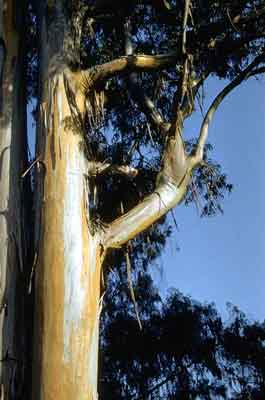
Charles Webber
*Blue
gum (Eucalyptus globulus, Myrtaceae)
This evergreen tree grows to about 45 m. (150
feet) tall. Its bark peels off in irregular
patches seasonally. The glaucous green leaves
of the older branches are 10- to 20 cm. (4 to
8 inches) long, lanceolate, somewhat sickle-shaped.
They are very aromatic. The sepals and petals
are fused into a warty-textured bud cap from
which a profusion of cream-colored stamens emerges.
Bloom is from December through May. The 2-cm.
(1-inch) fruit is a warty, woody capsule. Blue
gum is found in disturbed areas.
Eucalyptus
comes from the Greek and means "well covered,"
referring to the bud cap. Globulus means
"small ball" or "small sphere." This species
is native to Australia. The Californian environment
is similar to that of its native Australia,
and it was brought here to be farmed for wood
for the furniture industry. However, it turned
out not to be suitable for that. It has proven
to be extremely invasive. Here there are no
animals that eat blue gum and keep its growth
in check, and it is very prolific. Also, because
of the oils it exudes, most other plants cannot
grow in its immediate vicinity. One might consider
a blue gum woodland as a blue gum barrens.
|
|

Western
sycamore (Platanus racemosa, Platanaceae)
This is a 10- to 35-m. (30- to 115-foot) deciduous
tree. Its bark peels off giving its trunk and
main branches a puzzle-like appearance. The
tree looks gnarled and it grows at seemingly
odd angles. This is due to anthracnose (Gnomonia
platani), a fungal infection. In years of cool,
wet spring weather, trees can be completely
defoliated by the disease. A new crop of leaves
later forms in the drier summer months. The
tree has 13- to 33-cm. (5- to 13-inch) palmate,
five-lobed, tomentose leaves. It has 1-cm. (1/2")
heads of yellow-green male flowers and red female
flowers from February through August. The bloom
is followed by a 2- to 3-cm. (1-inch), dense,
globose head of achenes. Western sycamore is
found in canyon and streamside habitats.
Platanus
comes from the Greek platys "broad,"
referring to the size of the leaves. Racemosa
comes from the Latin racem "a cluster,"
referring to the chains of fruiting heads.
Early
Californians fashioned the burl-like growths
of the aliso into bowls.
|
|
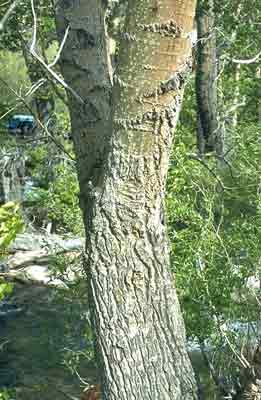
Brother Alfred Brousseau
Black
cottonwood (Populus balsamifera ssp.
trichocarpa, Salicaceae) This dioecious,
deciduous tree reaches 30 m. (100 feet) tall.
It has grayish, furrowed bark. Its 3- to 7-cm.
(11/4-to 23/4-inch) finely toothed, ovate leaves
are dark green above and paler green beneath.
Its inconspicuous flowers bloom in 3- to 8-cm.
(11/4- to 31/4-inch) catkins from February through
April. The 3- to 12-mm. (1/8- to 1/2-inch) fruit
is a dry capsule with hairy seeds. Black cottonwoods
are found at streamside places.
The
name Populus may be derived from pal
"to shake," referring to the way leaves of some
species, such as the quaking aspen, quiver in
a breeze. Balsamifera refers to the fragrant
gum covering the buds of this tree. Trichocarpa
means "hairy fruit."
The
alamo was used in a number of ways by
native Californians: housing, culinary implements
and containers, and clothing. Its bark made
a tea used to bathe broken or bruised limbs.
The leaves and bark were made into a poultice
to treat bruises and cuts. In Chumash oral tradition,
Old Man Sun carries a torch made of the inner
bark of cottonwood.
|
|
*Coast live oak, encina (Quercus agrifolia,
Fagaceae)
click
here for description
|
|
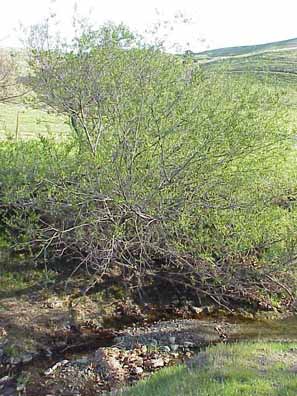
Arroyo
willow (Salix lasiolepis, Salicaceae)
This deciduous dioecious willow can grow to
be a 10-m. (30-foot) shrub or tree. It spreads
underground to form extensive clonal groups.
It has 4- to 12-cm. (11/2- to 5-inch) long,
narrow leaves on yellowish twigs. Its inconspicuous
flowers bloom in 15- to 70-mm. (1/2- to 23/4-inch)
catkins from March through May. Arroyo willows
are common in meadows and at springs.
Salix
is the classical Celtic name for the willow:
sal means "near," lis means "water."
Lasio means "shaggy/hairy," lepis
means "scale."
The
Spanish name for willow is sauce. The
leafy branches of willows were spread out for
a feverish person to lie on. A decoction of
its bark and leaves was used to bathe hemorrhoids.
The tea was also used to treat sore throats
(as a gargle) and to cure fevers and malaria.
Today, salicylic acid (from Salix) is
the active ingredient in aspirin. Chumash chewed
the bark to strengthen their teeth. They used
branches as fishing poles, switches, whips,
and firewood.
|
*California bay, California laurel, pepperwood,
bay-laurel (Umbellularia californica,
Lauraceae)
click here
for description
|
Associate
species include:
|
*Mugwort (Artemisia douglasiana,
Asteraceae)
click here for
description
|
|
|
*Chaparral
broom, coyote bush, coyote brush (Baccharis
pilularis, Asteraceae)
click here
for description
|
|
|
image
unavailable
Sedge
(Carex senta, Cyperaceae) This sedge
has up to 1-m. (40-inch) stems that are solid
and usually triangular. It grows in large, dense,
raised clumps connected by rhizomes. Leaf blades
are 3 to 5 mm. (1/8 to 1/6 inch) wide. Spikelets
measure approximately 21/2 to 5 cm. (1 to 2
inches). They have male flowers toward the tip
and 25 to 100 sessile perigynia below. Perigynia
are sac-like structures that house the female
flowers. Female flowers have two stigmas each.
The 3- to 4-mm. (1/8- to 1/6-inch) fruit is
a two-sided achene. This sedge is found along
streambanks, among rocks in stream channels,
and among rocks in stream channels.
Carex
comes from the Latin and means "cutter," in
reference to the sharp edges of the leaf and
stem. Senta is Latin for "rough, foul,
uncared-for."
|
|
|
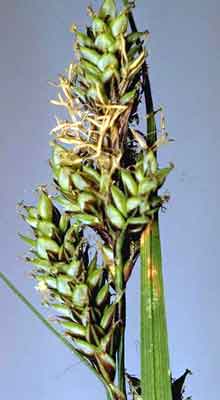
Charles Webber
Sedge
(Carex spissa, Cyperaceae) This sedge
has 1- to 2-m. (3- to 61/2-foot) stems that
are solid and usually sharply triangular. It
grows in large, dense clumps connected by rhizomes.
The inflorescence is at least 4 cm. (11/2 inch)
long. The top one to five spikelets are male,
and there are at least two female spikelets
below, each with 150 to 300 perigynia. Perigynia
are sac-like structures that house the female
flowers. Each female flower has three stigmas.
The fruit is a three-sided, beaked achene. This
sedge occurs along waterways and hillside seeps.
It may occur in serpentinitic areas.
Carex
comes from the Latin and means "cutter," in
reference to the sharp edges of the leaf and
stem. Spissa means "compact, thickened."
|
|
|
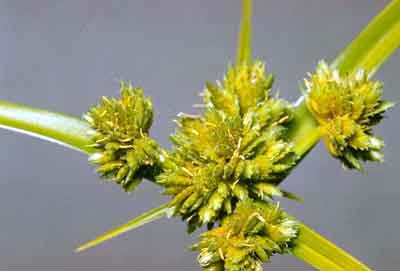
Charles Webber
Umbrella
sedge, nutsedge, galingale (Cyperus eragrostis,
Cyperaceae) Umbrella sedge is a perennial with
10- to 90-cm. (4- to 36-inch) stems. The stems
are solid and triangular. The terminal inflorescence
contains 20 to 70 flat spikelets. Flowers are
bisexual with three stigmas. The fruit is a
tiny brown, three-sided, beaked achene. Umbrella
sedge is found along streambanks and in ditches.
Cyperus
is the ancient Greek name for "rush" or "sedge."
Er means "spring" and agrostis
means "grass."
|
|
|
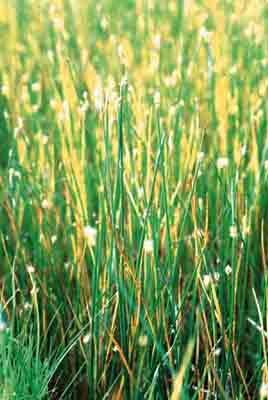
Spikerush
(Eleocharis macrostachya, Cyperaceae)
This is a 1/2- to 1-m. (11/2- to 3-foot) perennial
that spreads by rhizomes. Stems are round and
solid. The inflorescence is a single, terminal
spikelet of bisexual flowers with two-branched
styles. The fruit is a two-sided or round whitish-brown
achene. Spikerush is found in marshy areas,
along pond margins, and in ditches.
Eleocharis
is Greek for "marsh grace." Macro is
Latin for "large," stachus is Greek for
"point."
|
|
|
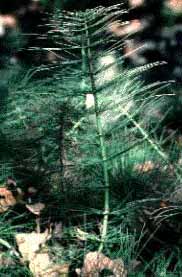
Giant
horsetail (Equisetum telmateia, Equisetaceae)
This ia a perennial that spreads via rhizomes.
Its stems are hollow (except at the nodes).
They are ridged lengthwise. Sterile green stems
are 30 to 100 cm. (1 to 3 feet) tall and have
many slender, whorled branches. The sterile
stems form in late winter and persist through
the growing season. Fertile, fleshy, brown,
unbranched stems are 15 to 45 cm. (6 to18 inches)
tall and are tipped by cone-like strobili that
produce masses of green spores. The fertile
stems are ephemeral, produced in winter and
withering soon afterward. Giant horsetails are
found along streambanks, in ditches, and in
seepage areas.
Equus
is Latin for "horse," seta means "bristle,"
and telma means "pond."
Canutillo
and caņutillo are Spanish words derived
from the Mozarabic cannut. They are the
diminutive forms of canuto and caņuto,
meaning small tube or container or, botanically,
internode. Horsetails were used by Chumash as
sandpaper, for gray dye, as a purgative, and
as a cure for venereal disease.
|
|
|
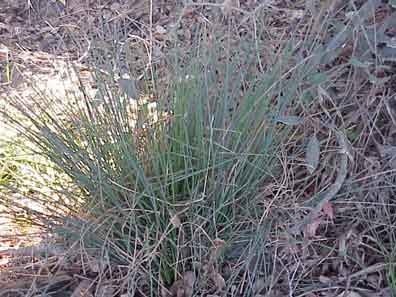
Rush
(Juncus effusus, Juncaceae) This is a
perennial species. Its 6- to 130-cm. (21/2-
to 51-inch), round stems grow in clumps and
spread by stout, branched rhizomes. Leaves are
basal and have no blade. The terminal inflorescence
appears to be lateral; each has many flowers.
Each flower has three stamens. The fruit is
a somewhat truncate obovoid capsule with 1/2-cm.
(1/4-inch) seeds that have a single minute appendage.
This rush is found in wet places.
Juncus
comes from the Latin, "to join" or "to bind."
Effusus means "spread out, extensive,
loose, unrestrained."
Juncos,
in Spanish, were used extensively by Chumash
in basketry and other weaving projects (clothing,
beading, mats). They were also used to string
up abalone to dry.
|
|
|
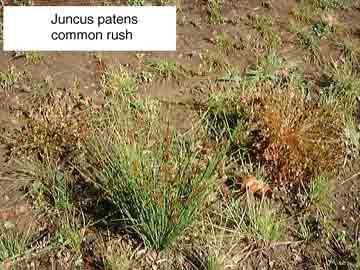
Spreading
Rush (Juncus patens, Juncaceae) This
is a perennial species. The 30- to 90-cm. (12-
to 36-inch) stems form clumps and spread by
stout branched rhizomes. The bluish-gray-green
stems are distinctively grooved lengthwise.
The leaves are basal and bear no blades. The
terminal inflorescence appears to be lateral.
Each has many flowers, these with six stamens
each. The fruit is a spheric capsule with a
soft beak. Seeds are 1/2 cm. (1/4 inch) long.
They are asymmetric and bear minute appendages.
Spreading rush occurs in marshy places.
Juncus
comes from the Latin, "to join" or "to bind."
Patens means "spreading" or "open."
Juncos,
in Spanish, were used extensively by Chumash
in basketry and other weaving projects (clothing,
beading, mats). They were also used to string
up abalone to dry.
|
|
|
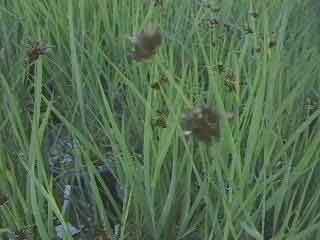
Brown-headed
rush (Juncus phaeocephalus, Juncaceae)
This is a perennial species. It has 10- to 50-cm.
(4- to 20-inch) stems spreading from stout rhizomes.
The stems and leaf blades are flat. The inflorescence
has a one to many flower clusters. Each flower
has six stamens and stigmas that are long-exserted.
The fruit, a capsule, has a long, tapered beak.
The ovoid seeds are 1/2 cm. (1/4 inch) long.
This rush is found in moist places.
Juncus
comes from the Latin, "to join" or "to bind."
Phaeo means "brown" or "dark," cephalus
means "head."
Juncos,
in Spanish, were used extensively by Chumash
in basketry and other weaving projects (clothing,
beading, mats). They were also used to string
up abalone to dry.
|
|
|
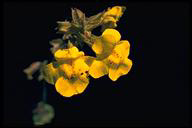
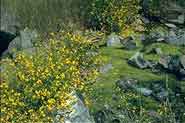
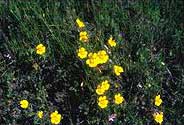
Seep
or common monkeyflower (Mimulus guttatus,
Scrophulariaceae) The seep monkeyflower is usually
a perennial. It is 5 to 100 cm. (2 to 40 inches)
tall. It spreads by stolons. It is herbaceous
and has fleshy, green, opposite, toothed, rounded-ovate
leaves. It has bright yellow flowers with red
spots in their hairy throats. They bloom from
March through September. The fruit is an oval
capsule. Seep monkeyflower is found along streambanks
and wet places.
Mimulus
comes from the Latin mimus "a comic actor"
because of the "monkey-face" markings on the
flowers of some species of Mimulus. Gutta
means "drop," referring to the red droplet-like
markings on flowers in this species.
|
|
|
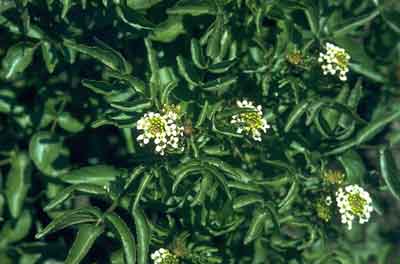
Brother Alfred Brousseau
Water
cress (Rorippa nasturtium-aquaticum,
Brassicaceae) This perennial herb is often prostrate
in standing water or slow-running streams. The
stems root at the nodes. Its shiny green leaves
are pinnately divided with leaflets measuring
to 10 cm. (4 inches) long. The 3-mm. (1/8-inch)
flowers have four white petals each and bloom
from March through November. The long, slender
pod-like fruits are called siliques. Water cress
is found along streams and at springs.
Rorippen
is an old Saxon word. Nasturtium means
"twisted nose" because of the pungency of the
plants. Aquaticum means "found in the
water."
,
in Spanish, were introduced from Europe and
reportBerrosed from Price Canyon as early
as 1769. They were eaten raw (for liver ailments)
and cooked (as tea for hangovers).
|
|
|

Brother Alfred Brousseau
Ground
rose (Rosa spithamea, Rosaceae) This
is a 50-cm. (20-inch) dwarf shrub with rhizomes
and prickly stems. It has two to four double-toothed
leaflets per leaf. Each inflorescence has one
to ten pale pink flowers. Fruits are achenes
enclosed in the hip. Ground rose is found in
open woodlands, as well as chaparral, especially
after fire.
The
etymology of rosa is unknown. It may
be either the ancient Latin name for rose or
derived from the Celtic rhod meaning
"red." Spithamea derives from spithama
meaning "a span, measure equal to the distance
between the first and last fingers of an outstretched
hand, approximately seven inches."
The
fruit of rosa de Castilla, in Spanish,
was used by Chumash. It was eaten raw or strung
for necklaces or earrings. The petals were dried
and used as a tea to cure colic, as an eyewash,
to soothe teething babies, and, powdered, as
talc.
|
|
|
*California blackberry (Rubus ursinus,
Rosaceae)
click
here for description
|
|
|
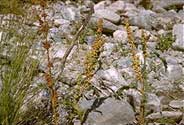
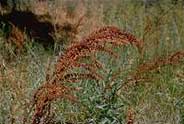
Curly
dock (Rumex crispus, Polygonaceae)
This is a 30-cm to 120-cm. (1- to 4-foot) introduced
perennial species. It has a taproot. Its 50-cm.
(20-inch) lanceolate leaves have curled margins.
Dense, leafy panicles of green flowers bloom
most of the year; then shiny brown fruits, achenes,
develop. Curly dock occurs in disturbed places.
Rumex
is Latin for "sorrel." Crispus means
"curled."
Lengua
de buey ("bull's tongue" in Spanish) was
brought from Eurasia, but it is suspected that
the native Rumex salicifolius was used
by Chumash in the same manner. Its leaves were
eaten as greens; the peeled, raw stem resembles
a sour version of celery; the seeds were pounded
into a mush; and the root was boiled into a
tea to cure stomach ailments.
|
|
|
*Blue elderberry (Sambucus mexicana,
Caprifoliaceae)
click here
for description
|
|
|
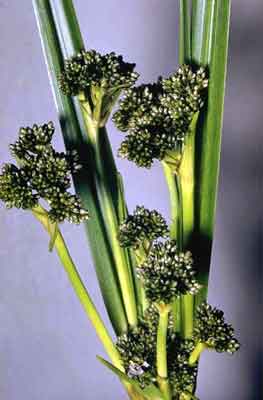
Charles Webber
Small-headed
bulrush (Scirpus microcarpus, Cyperaceae)
This is a 30- to 150-cm. to (1- to 5-foot) perennial
with hollow triangular stems. Its inflorescence
is panicle-like and consists of fifty or more
spikelets in head-like clusters of four to twelve
at branch tips. This bulrush occurs along streambanks,
in wet meadows and marshy areas.
Scirpus
is the classical name for "bulrush." Microcarpus
means "tiny fruit."
|
|
|
*Western poison oak (Toxicodendron diversilobum,
Anacardiaceae)
click here
for description
|
|
|
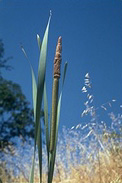
Broad-leaved
cattail (Typha latifolia, Typhaceae)
This is a perennial that spreads by rhizomes.
It grows in water (not underwater) or in drier
soil. It has a spike-like, terminal, cylindrical
inflorescence of a thousand or more flowers.
The male flowers grow toward the tip of the
inflorescence; the female flowers below. Flowers
bloom from June to July. This cattail is common
in marshy areas and ponds.
Typha
is the ancient Greek name for "cattail." Latifolia
means "broad leaf."
Tule
ancho means broad, wide tule, in Spanish.
Tules were used by Chumash for thatching, weaving
mats and canoes, and occasionally in basketry,
and for splinting broken limbs. The ashes were
used to massage the skin for relief from rheumatism.
Stems were made into "straws" used for sucking
liquid tobacco. Tule was used for archery
targets and in rituals. Two other types of tules
were recognized by the Chumash: tule redondo
(round, the shape of the stems): Scirpus
acutus and S. californicus; and tule
esquineado (probably an aberration of esquinado
meaning having corners, referring to the triangular
stems): Scirpus americanus.
|
|
|